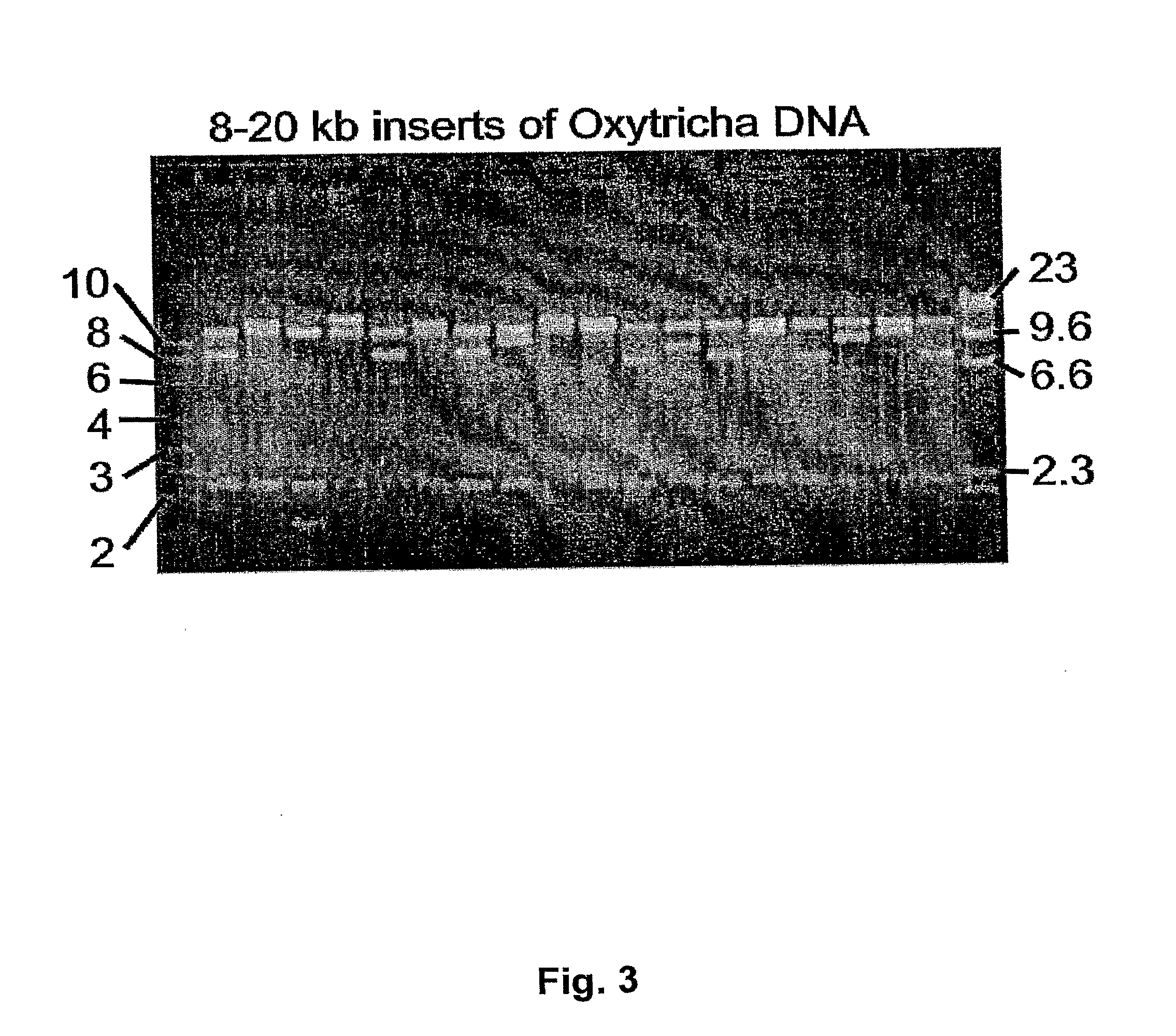Linear vectors, host cells and cloning methods
- Summary
- Abstract
- Description
- Claims
- Application Information
AI Technical Summary
Benefits of technology
Problems solved by technology
Method used
Image
Examples
example 1
Construction of Host Strains for Linear Vectors
[0056]A standard, commercially available strain of competent E. coli (E. CLONI 10G, Lucigen, Middleton, Wis.) was used to prepare host cells for efficient transformation with linear vectors of the invention. To create one host strain (referred to herein as E. CLONI® 10G-iTel), the telN gene was PCR-amplified from phage N15 DNA (Ravin et al., J. Mol. Biol. 299(1):53-73 (May 2000), the disclosure of which is incorporated herein by reference) using the following primers:
telN-F: GCGGATCCCGATATCCAGAGACTTAGAA (BamHI site underlined) (SEQ ID NO: 42)
telN-R: CGAAGCTTCTTTTAGCTGTAGTACGTTTC (HindIII site underlined) (SEQ ID NO: 43)
[0057]The resulting PCR product was cloned into the BamHI / HindIII sites of pGZ119EH, which allows cloning of the target gene under control of IPTG-inducible Ptac promoter (Lessl et al., 1992, J. Bacteriol., 174: 2493-2500, incorporated herein by reference). The recombinant vector, designated pGZ-telN, expresses telN prote...
example 2
Construction of Linear Vectors
[0062]a) Construction of NZCK3
[0063]A linear vector suitable for general cloning was derived from pG591 (SEQ ID NO:1). (Ravin et al., Nucleic Acids Res. 31(22):6552-60 (2003), the disclosure of which is incorporated herein by reference) pG591 was digested with NotI and treated with a mixture of DNA repair enzymes that generates blunt, phosphorylated ends (DNATERMINTOR® Kit, Lucigen, Middleton, Wis.). The 12 kb fragment containing the left telomere, telN, repA, and kanamycin resistance was gel isolated. pG591 was also digested with BglII, and the 1.3 kb fragment containing the right telomere was gel isolated.
[0064]A fragment containing the lacZalpha and ampicillin genes was constructed as follows: The lacZalpha gene of the vector pEZ BAC (SEQ ID NO: 15, nucleotides 155-598) was PCR amplified using the two overlapping forward primers T7RC-NotF (SEQ ID NO:16) and NSAS-LacZ-F (SEQ ID NO:17) plus the reverse primer NNASA-LacZ-R (SEQ ID NO:18) to create a fra...
example 3
Construction of a Tetrahymena thermophila 6-20 Kb Genomic Library
[0071]T. thermophila is a free-living, widely distributed, ciliated protozoan. The cellular, structural, and functional complexity of this organism is comparable to that of human and other metazoan cells. The macronuclear (somatic) genome consists of 160 Mb processed in vivo into ˜300 sub-chromosomal fragments. Constructing libraries with inserts of >6 kb is extremely problematic for this genome, presumably because the AT content ranges from 75-85%.
[0072]The linear pNZKA vector was used to successfully clone libraries of large AT-rich fragments. A library of 5-10 kb fragments of the Tetrahymena genome was created by ligation of sheared, end-repaired macronuclear DNA to a blunt digest of pNZKA. Of 54 clones analyzed, 51 had inserts of the expected size (data not shown).
[0073]A library was also successfully created with clones in the range of 6-20 kb, which to our knowledge, represents a library of the largest Tetrahymen...
PUM
 Login to View More
Login to View More Abstract
Description
Claims
Application Information
 Login to View More
Login to View More - R&D
- Intellectual Property
- Life Sciences
- Materials
- Tech Scout
- Unparalleled Data Quality
- Higher Quality Content
- 60% Fewer Hallucinations
Browse by: Latest US Patents, China's latest patents, Technical Efficacy Thesaurus, Application Domain, Technology Topic, Popular Technical Reports.
© 2025 PatSnap. All rights reserved.Legal|Privacy policy|Modern Slavery Act Transparency Statement|Sitemap|About US| Contact US: help@patsnap.com



